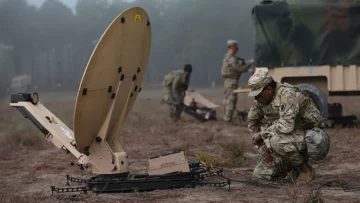
With so much new technology in the commercial market, the Army is searching for a new way to buy satellite services
NATIONAL HARBOR, Md. — The U.S. Army is in the market for satellite communications but with a complicated twist. It is not just looking to buy broadband for troops in the field but “end to end” services and durable hardware that can be deployed in austere locations and provide connectivity within hours.
“We certainly need for our tactical units to have an expeditionary network,” Brig. Gen. Robert Collins, program executive officer for Army tactical networks, said Sept. 8 during a panel discussion at the Satellite 2021 conference.
With so much new technology in the commercial market, the Army is searching for a new way to buy satellite services. Rather than lay out a wish list and have the industry respond, it wants to see what the industry has to offer before it writes the solicitation, Collins said. “We’re doing things a little bit differently.”
Commercial satellite operators, antenna manufacturers and integrators have been invited to show the Army whether they can deliver on this vision. Depending on the results of the demonstrations, Collins’ office at Aberdeen Proving Ground, Maryland, will draft a solicitation for bids.
The industry’s ability to provide what the Army calls “satcom as a managed service” is still a matter of debate even as the playing field grows and the industry adds unprecedented levels of space-based network capacity.
The Army last year issued a call for proposals for satcom services for its logistics network but has since expanded the scope of its market research “to understand how an end-to-end satcom as a managed service model could support he Army’s tactical network as a whole,” said a request for information issued in June. The desire is for commercial satellite-based communications integrated with ground systems, gateways and user terminals.
Satcom as a service is not a new concept for the military. The Pentagon in 2019 purchased satcom as a managed service from satellite operator Iridium. The company got a $738.5 million, seven-year, contract to provide satellite services from its low Earth orbit (LEO) constellation to military users.
But the military now wants satcom services that bring in a mix of providers and satellites from LEO and other orbits, and satellites that operate in different frequencies. That requires a more complex integration of networks and interoperability in ground systems and terminals.
Clare Grason, chief of the U.S. Space Force’s Commercial Satellite Communications Office, said multi-layer, multi-band satcom services are the way of the future.
“Going forward we are looking to replicate the Iridium model for greater commercial satcom partnerships,” she said at the panel.
Grason’s office currently manages $4.6 billion worth of contracts but most are for satellite bandwidth, not for managed services. She said there is a plan to acquire commercial satcom in the future “as an inventory of capabilities” that military users would be able to choose from. The concept is still being fine tuned, she said.
Satellite operators becoming ‘integrators’
The Pentagon frequently turns to large systems integrators to bring together diverse technologies and products into a single program. These integrators also sell their own products.
A similar trends is happening in the satcom industry, said Dave Micha, president of satellite operator Intelsat General.
“With the big DoD integrators, some pieces they build themselves, for others they partner. That’s what the satellite industry is moving towards,” Micha told SpaceNews.
Intelsat will be one of the companies trying to sell satcom as a managed service to the Army. He said a demonstration is planned in the coming weeks.
Intelsat operates its own geostationary communications satellites but will be offering more comprehensive services that includes non-GEO satellite broadband, said Micha. He declined to provide details but said Intelsat will be soon announcing plans to offer non-GEO satcom.
The military needs the satellite industry to adopt common standards so it can buy satcom as easily as consumers when they go to an Apple store to buy an iPhone, said Micha.
“In our industry traditionally things are proprietary,” he said. “We’re proposing an open architecture, 5G based. We’re focused on providing the entire ecosystem.”
Micha said Intelsat also is developing new terminals that are compatible with multiple satcom networks.
Intelsat’s business strategy would put it in competition with established integrators that provide managed satcom services from many providers.
Dave Fields, senior vice president and general manager of Leonardo DRS Global Enterprise Solutions, cautioned that satellite operators are mostly motivated to sell their own solutions whereas true integrators are completely agnostic.
Leonardo DRS is one of a handful of satcom integrators that work with DoD and other government agencies.
“Our angle is that I don’t want to sell you what I make, I want to sell you what’s right for you as a customer,” Fields said in an interview.
DoD needs access to all satcom systems so it has resiliency, Fields said.
For example, if a LEO system that operates in the Ku band is jammed, it doesn’t matter how many satellites are in the network, DoD won’t be able to use that service. “That’s where multiple bands come into play” and users could switch to a Ka band system, he added. “If I’ve got one antenna that’s both Ku and Ka band, now you’re starting to talk about resiliency, and that’s what we want our customers to get to.”
- 2019
- 2021
- 5G
- access
- All
- antenna
- appetite
- Apple
- architecture
- Army
- Billion
- Bit
- broadband
- build
- business
- buy
- call
- Capacity
- chief
- Collins
- coming
- commercial
- Common
- Communications
- Companies
- company
- competition
- Conference
- Connectivity
- Consumers
- contract
- contracts
- Customers
- Dave
- debate
- DoD
- ecosystem
- Enterprise
- Enterprise Solutions
- executive
- Fields
- fine
- Forward
- future
- General
- Global
- Government
- Growing
- Hardware
- How
- HTTPS
- industry
- information
- integration
- Interoperability
- Interview
- inventory
- iPhone
- IT
- large
- List
- logistics
- Market
- market research
- Maryland
- Military
- million
- model
- network
- networks
- offer
- offering
- Officer
- open
- Other
- Others
- partner
- partnerships
- pentagon
- president
- Products
- Program
- research
- Results
- ROBERT
- satellite
- satellites
- sell
- Services
- So
- Solutions
- Space
- standards
- store
- Strategy
- support
- Switch
- system
- Systems
- tactical
- Technologies
- Technology
- The Future
- Trends
- twist
- u.s.
- users
- Vice President
- vision
- within
- Work
- worth
- year









